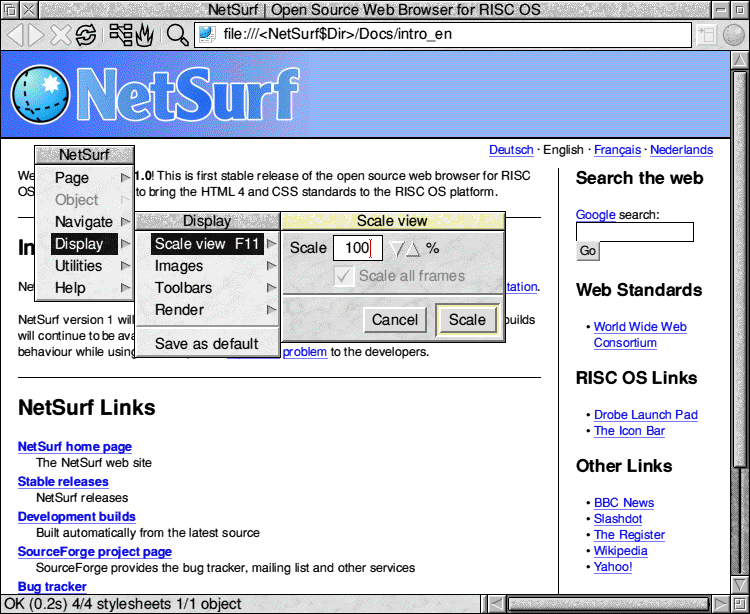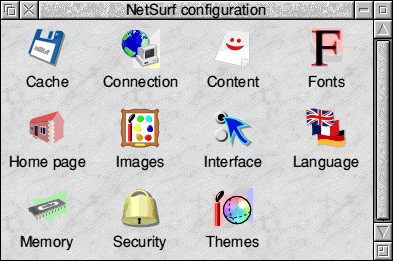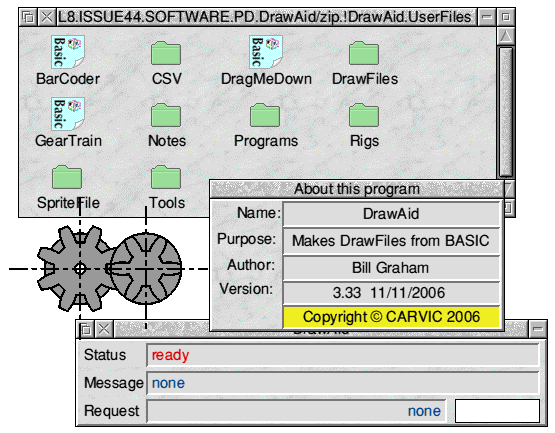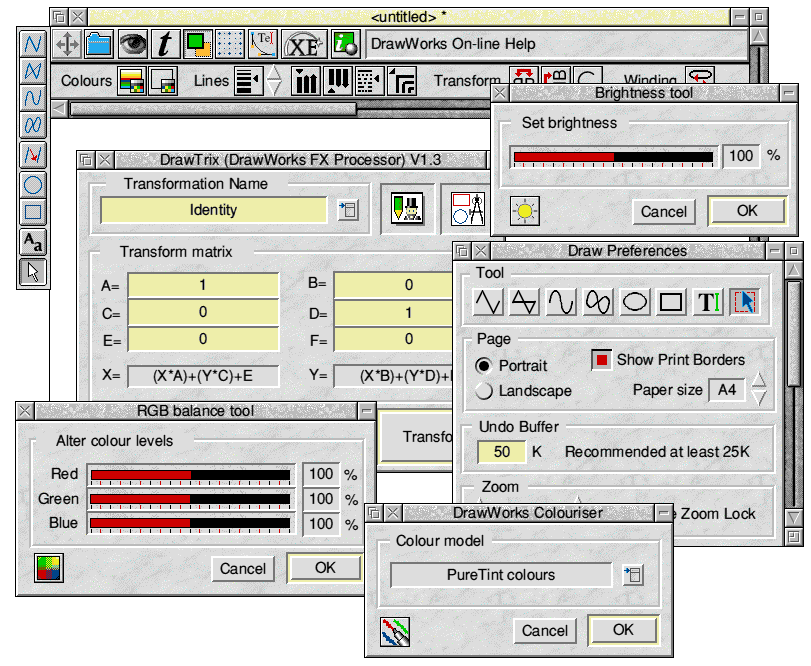



PD World
Paul Brett with the latest freeware and PD releases for RISC OS.
Welcome back to our regular round up of the latest freely available RISC OS software. Having recently returned from the Wakefield show I am delighted to say that there is one new major software release that I have to cover before moving on to other applications.
NetSurf - Netsurf developers
For those of you who are not aware of NetSurf I feel it's worth explaining what it is. NetSurf is an open source web browser for RISC OS. There are two ways of getting a new browser to run on RISC OS. There is the approach taken by Peter Nauls with FireFox, that is to port an existing browser from another platform to RISC OS. This has the benefit that you get a feature rich product, but as the browser is intended to run on much more powerful machines it will be slow on most RISC OS computers. You also have the problem of wading through reams of code that you haven't written and trying to work out what it is supposed to do. In addition you have to write a new GUI (Graphical User Interface) that supports RISC OS but maps to what the browser expects to happen.
The second approach, and that taken by the NetSurf developers, is to start from scratch and write a browser designed for RISC OS. The browser may not have as many features but is designed to be a RISC OS application from the start. It also mean that since the browser can use features specific to the target OS it is likely to be considerably faster.

NetSurf
NetSurf has been in development for some time and beta releases have been available for a couple of years. As such it's been possible to see the development process in action. If you compare the new NetSurf version 1.00 to the older beta versions then the huge amount of work that has been undertaken becomes very apparent. NetSurf may not have all the feature of some other RISC OS browsers, for example it does not support JavaScript, but it is an excellent general purpose browser for most websites.
NetSurf comes with an informative well written manual that's designed to be read by users, not developers, and also comes with a myriad of configure options which can be found from the iocnbar menu.

NetSurf configuration
NetSurf is fully RISC OS compliant, works quickly even on lowly 200Mhz StrongArm machines and I can't recommend it strongly enough. The entire RISC OS community should applaud the developers for the huge amount of time and efforts they have put in on our behalf. Since I am including a copy in the PD directory you really should give NetSurf a go. If you like it then please do make a financial contribution (however large - ED) to support the work that's been done.
Cmosd - Carlos Santillan
This is such a surprising sensible little gadget that I am amazed that no one has come up with it before. RISC OS computers store some of their configuration settings in a special bit of memory on the motherboard (called CMOS RAM). The contents of the CMOS are preserved even if the computer is switched off and unplugged from the mains. A small battery preserves this memory. You may have seen old RISC OS computers that haven't been used for a long time show odd effects, such as forgetting which monitor is configured, or which drive to Boot from, this is because the battery has failed and the information in the CMOS memory has been lost.

Cmosd - don't forget to read the waning file before using it
CMOSD checks the state of the CMOS memory every 30 seconds. If the CMOS has changed it takes a copy of the CMOS and saves it as file called CMOS, which can be found inside the !Cmos application. As a word of warning before running Cmosd on any machine open up the application (hold down SHIFT and double click on it) to make sure that a CMOS file from another machine isn't present. If one is present then delete it before running Cmosd.
Since a copy of the CMOS is taken every time it has changed you will be able to recover the correct CMOS settings for your machine if something nasty happens. Cmosd was written for us on the A9home but can also be used on any other RISC OS computer with RISC OS 3.11 or later.
DrawAid - Bill Graham
DrawAid is an easy-to-use Wimp interface allowing a Library of Basic drawing procedures to be called by simple (or complex) User's BASIC programs. From these User programs complex Drawfiles may be generated and displayed. The application can be used to produce mathematically or parametrically defined drawings and can produce a sequence drawfiles from the one program.

DrawAid along with a pair of gears
The first version of DrawAid was written in 1991, and it has received steady development up to the present version 3.33 in November 2006. This last version has been slightly modified to run on VirtualAcorn on Windows PCs. The drawfiles generated can also be loaded and edited by XaraXtreme.
A set of PDF documents that describe DrawAid and how to use it are included. I would suggest starting with the example programs to see what they do and how they work in order to get the best out of a very useful application.
DrawWorksXE - APDL
To coincide with the release of RISC OS 6 APDL have made new version of DrawWorksXE available. This version resolves a couple of minor issues with sprite handling on RISC OS 6 and is suitable for all versions of RISC OS. DrawWorks XE is the cut down freely available version of DrawWorks. I am sure that most users will be familiar with DrawWorks, however for those that are not a small explanation is required.
DrawWorks is a toolbar for Draw. It appears along the top or the bottom of the Draw window when a drawfile is loaded, or a new window is opened. The new toolbar allows the user to quickly access Draw's features from buttons, rather than having to navigate through the Draw menu structure. This doesn't sound especially impressive, but Drawworks is more than just a button bar. it also adds a large number of extra features to Draw.

DrawWorksXE
For example you can alter the colour tint of objects, copy colours from one object to another. Merge paths, to make shapes with holes in. Distort paths using the DrawTrix tool plus a host of other features. DrawWorksXE only comes with a small subset of the tools available in the full DrawWorksXL but is still a very capable and useful application. Once you have used Draw with DrawWorks you are very unlikely to want to go back to plain Draw.
I shall return with more software to tempt you next issue.
Paul Brett